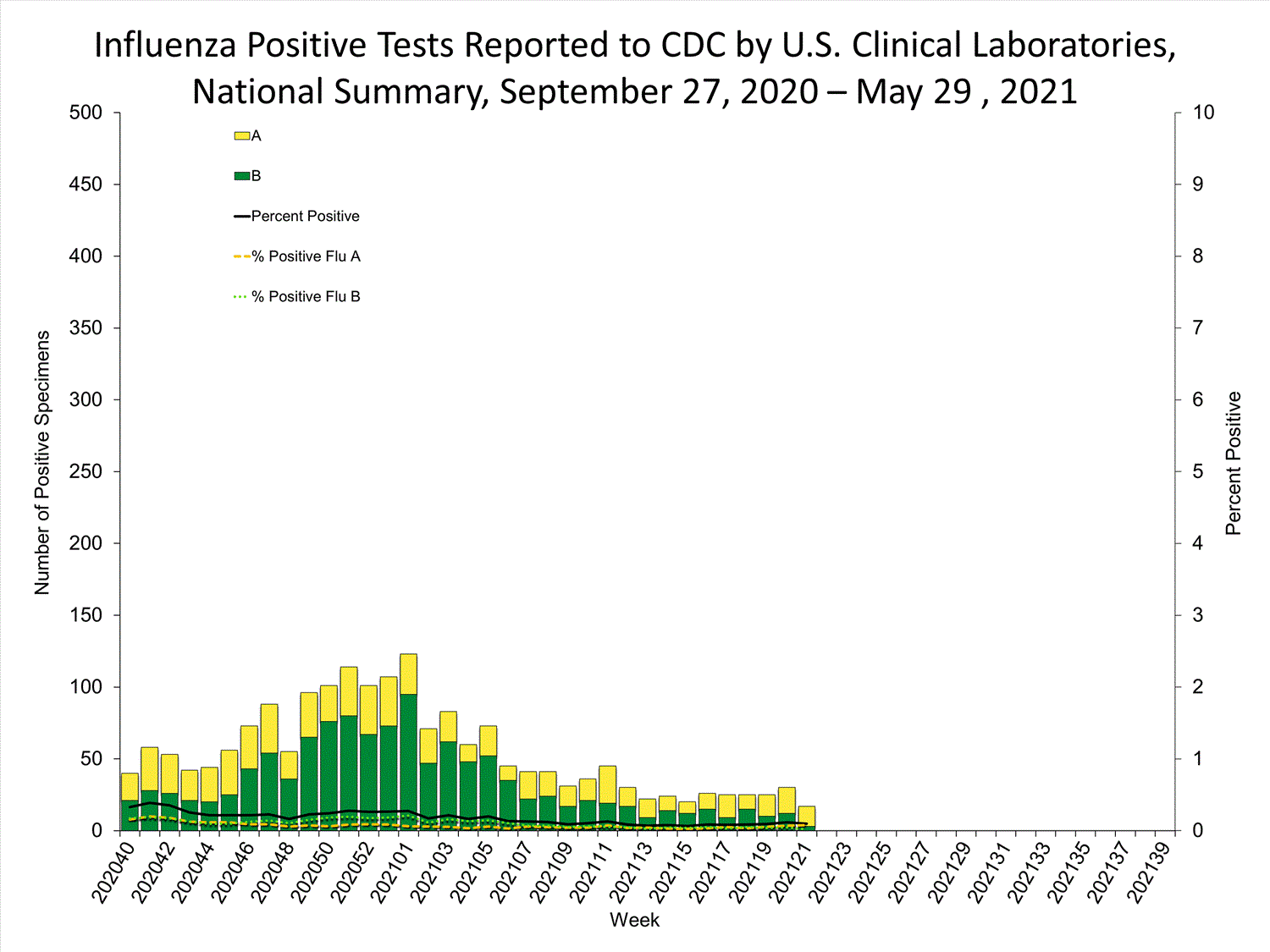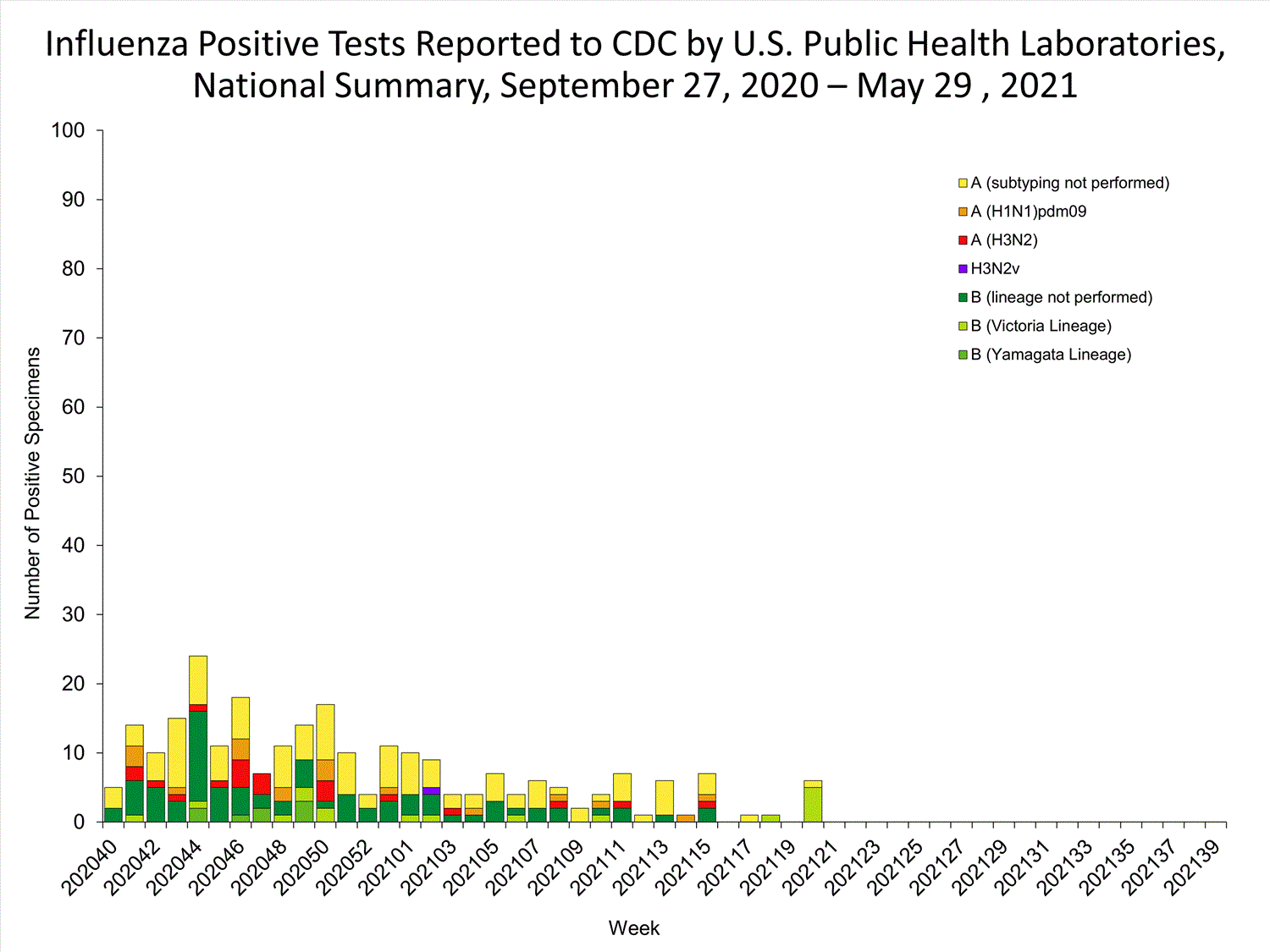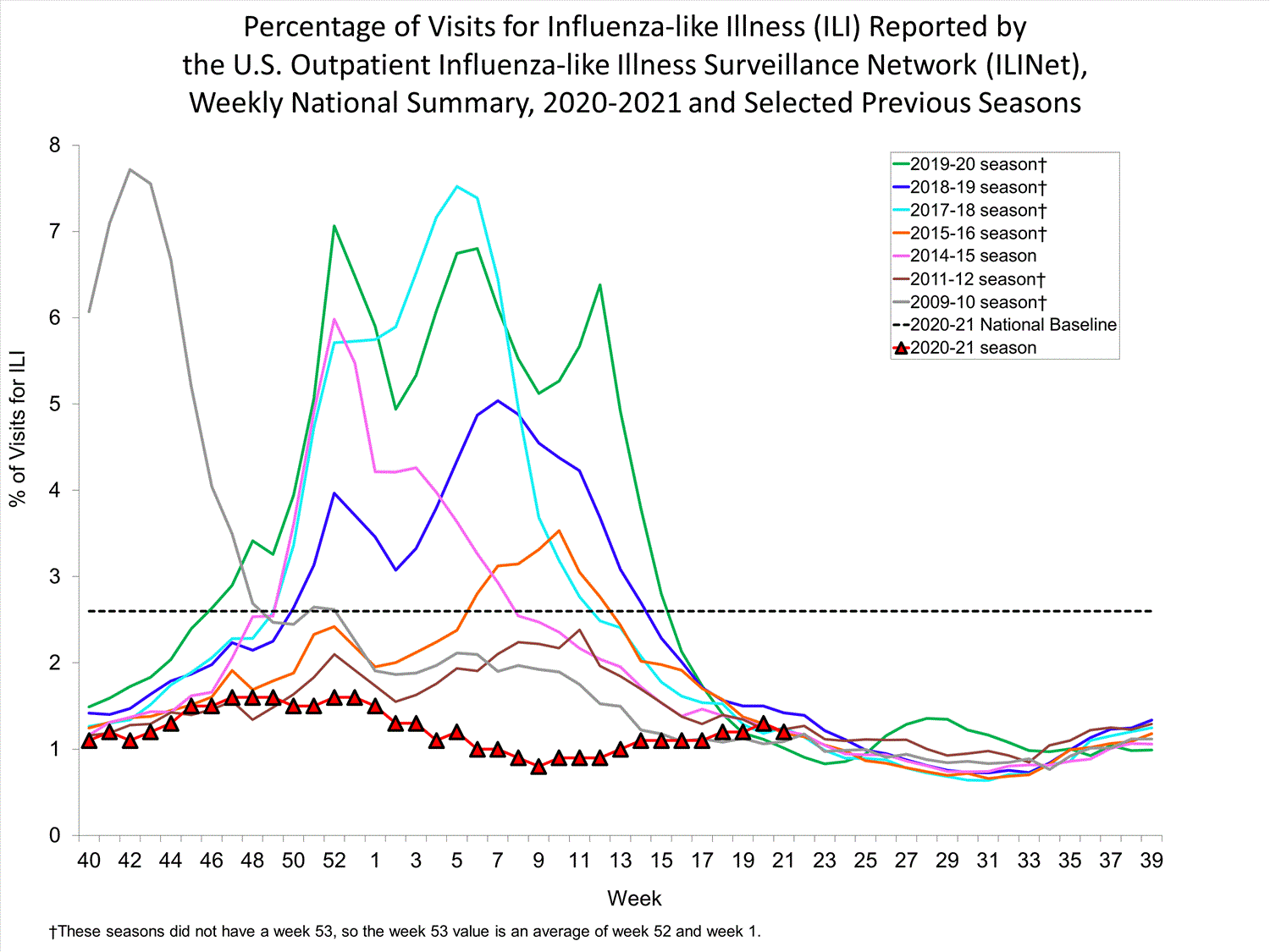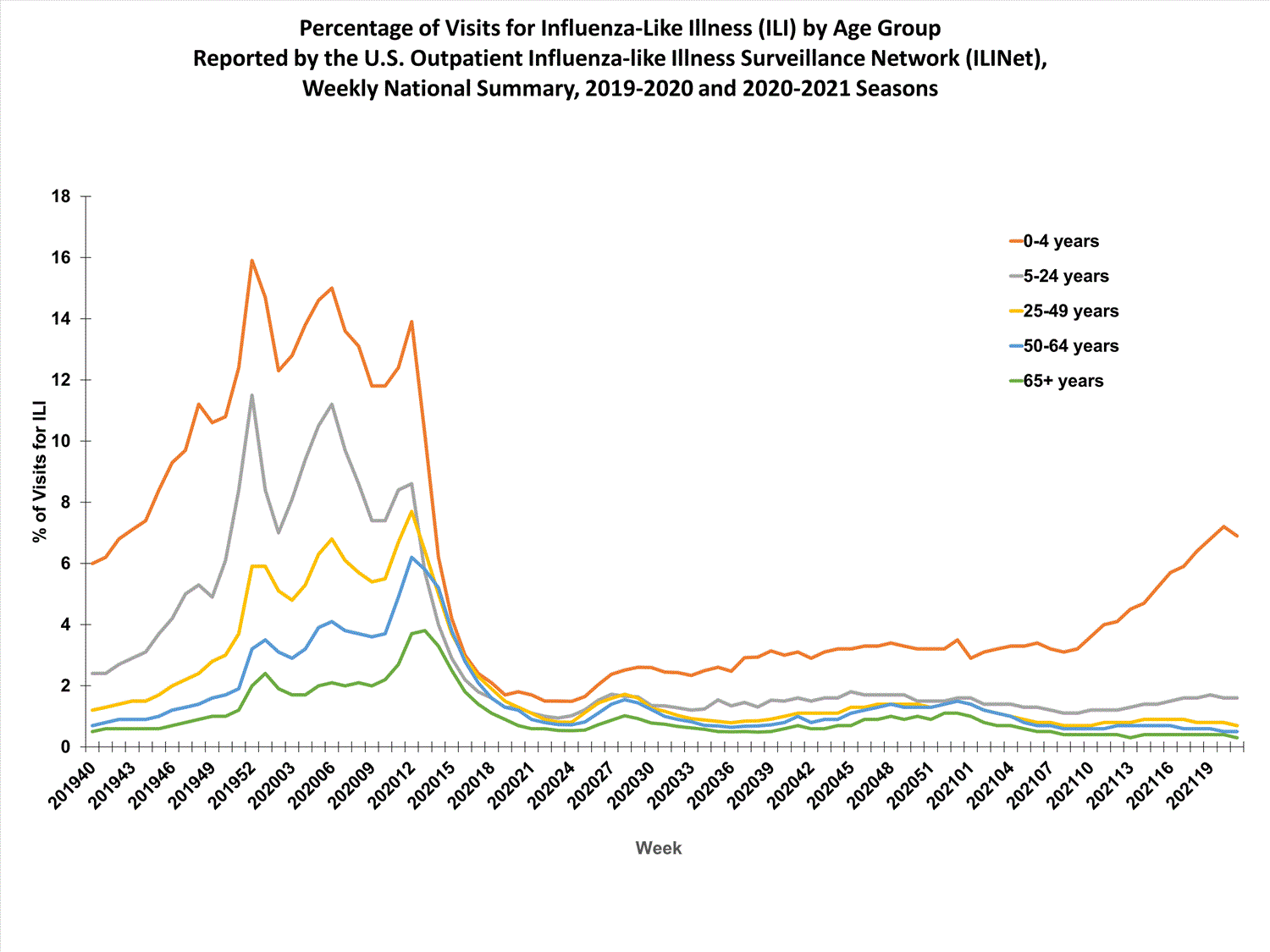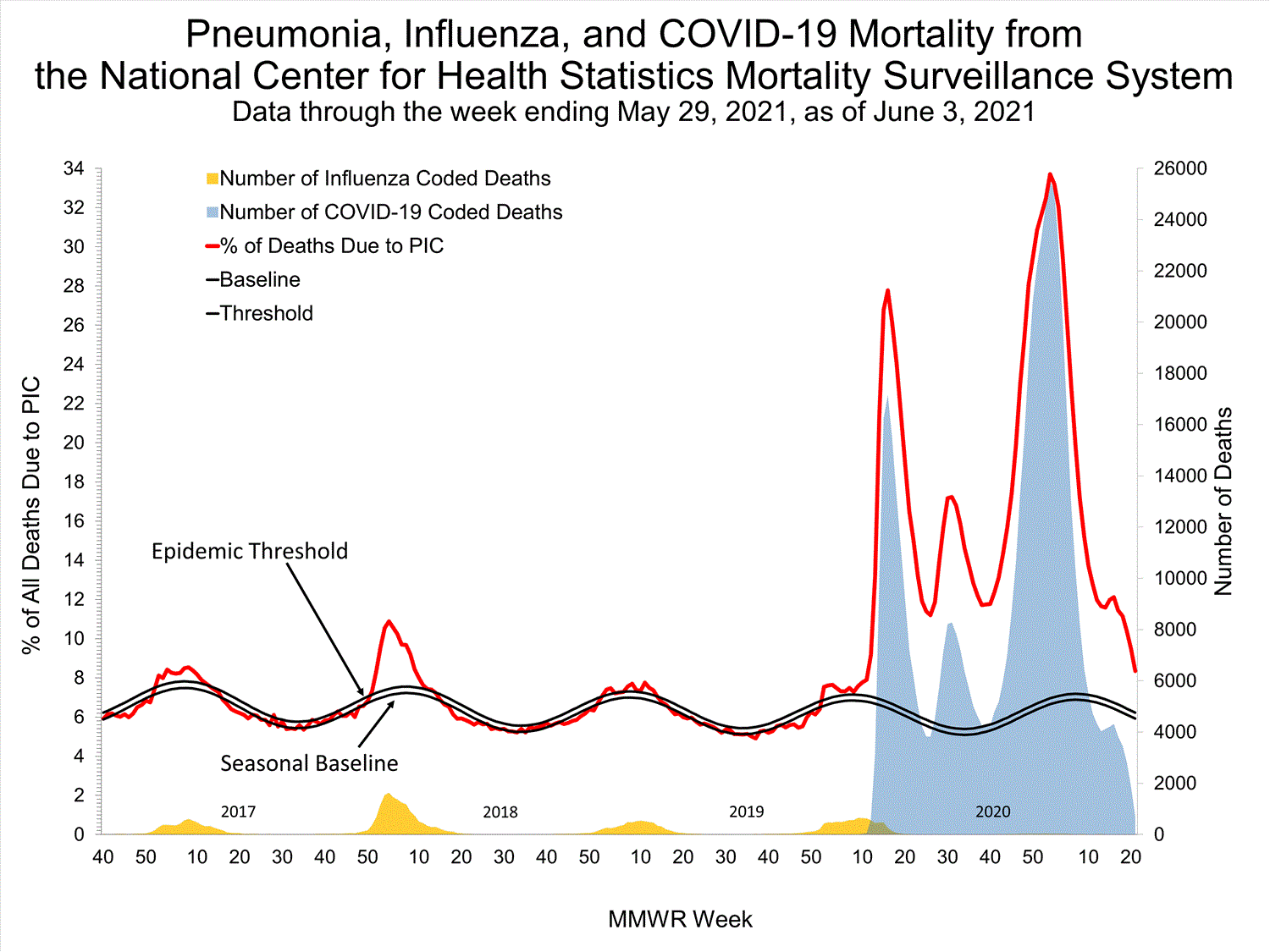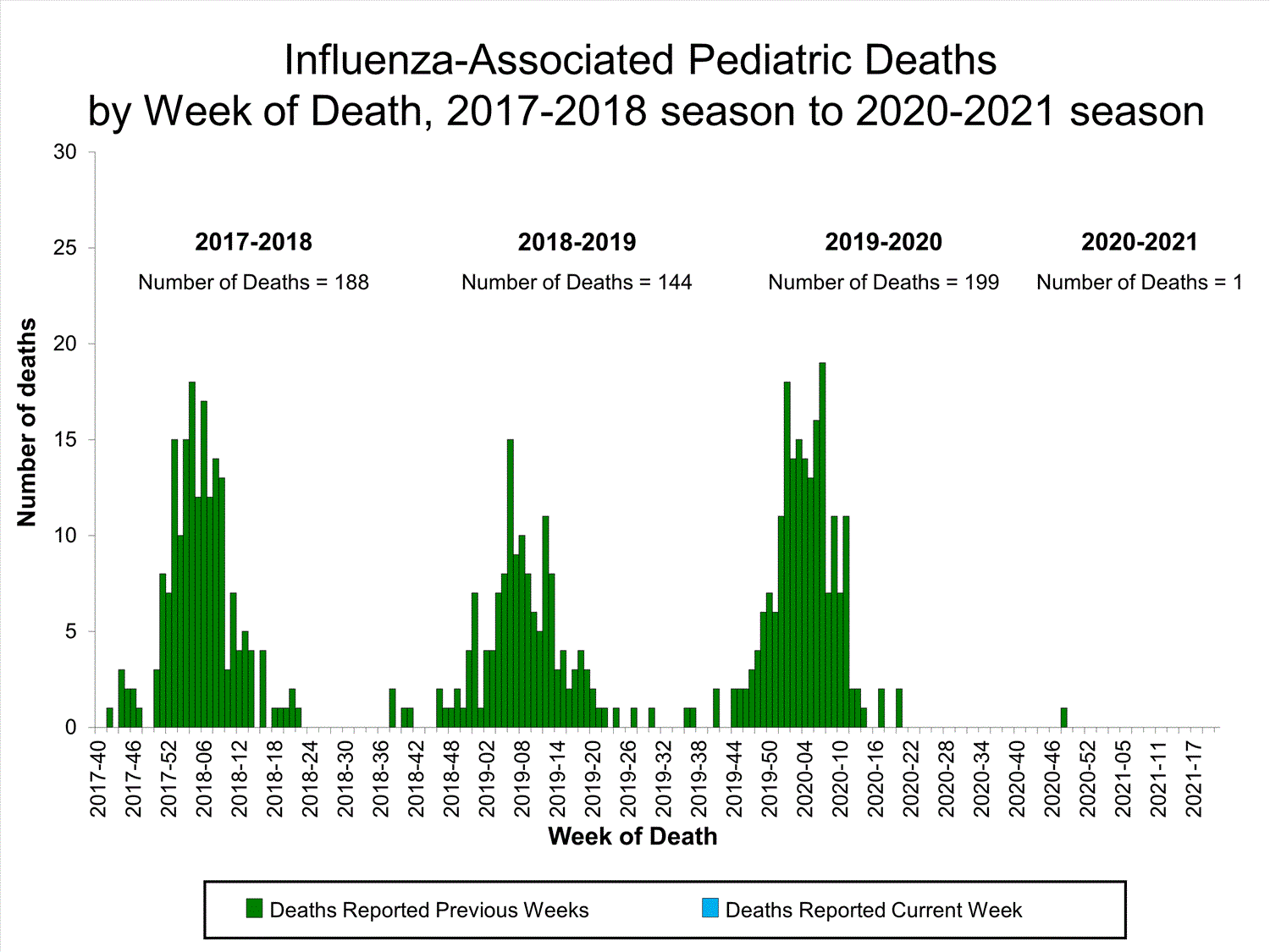FluView Summary ending on May 29, 2021

All data are preliminary and may change as more reports are received.
A description of the CDC influenza surveillance system, including methodology and detailed descriptions of each data component is available on the surveillance methods page.
Additional information on the current and previous influenza seasons for each surveillance component are available on FluView Interactive.
All data are preliminary and may change as more reports are received.
A description of the CDC influenza surveillance system, including methodology and detailed descriptions of each data component is available on the surveillance methods page.
Additional information on the current and previous influenza seasons for each surveillance component are available on FluView Interactive.
U.S. Virologic Surveillance:
Clinical Laboratories
Data from clinical laboratories (the percentage of specimens tested that are positive for influenza) are used to monitor whether influenza activity is increasing or decreasing.
Public Health Laboratories
Data from public health laboratories are used to monitor the proportion of circulating viruses that belong to each influenza subtype/lineage.
Novel Influenza A Virus
One human infection with an influenza A(H1N1) variant (A(H1N1)v) virus was reported by Iowa. The patient is >18 years of age, was not hospitalized, and has completely recovered from their illness. Investigation into the source of the infection revealed that the patient works on a farm with swine present. No human-to-human transmission of A(H1N1)v virus has been identified associated with this patient. This is the second influenza A(H1N1)v virus infection identified in the United States that occurred in 2021.
When an influenza virus that normally circulates in swine (but not people) is detected in a person, it is called a “variant influenza virus”. Five human infections with a novel influenza A virus have been reported in the United States this season, including one H3N2v (WI), one H1N2v (OH), and three H1N1v (IA, NC, WI) infections. Three infections have occurred in children <18 years of age and two have occurred in adults ≥ 18 years of age. All cases either had direct contact with swine or lived on a property with swine present.
Early identification and investigation of human infections with novel influenza A viruses are critical so that the risk of infection can be more fully understood and appropriate public health measures can be taken. Additional information on influenza in swine, variant influenza infection in humans, and strategies to interact safely with swine can be found at www.cdc.gov/flu/swineflu/index.htm. Additional information regarding human infections with novel influenza A viruses can be found at http://gis.cdc.gov/grasp/fluview/Novel_Influenza.html.
Additional virologic surveillance information for current and past seasons:
Surveillance Methods | FluView Interactive: National, Regional, and State Data or Age Data
Outpatient Illness Surveillance
Please note, the U.S. Outpatient Influenza-like Illness Surveillance Network (ILINet) monitors outpatient visits for influenza-like illness (ILI), not laboratory-confirmed influenza, and will capture visits due to other respiratory pathogens, such as SARS-CoV-2, that present with similar symptoms. In addition, health care-seeking behaviors have changed dramatically during the COVID-19 pandemic. Many people are accessing the health care system in alternative settings, which may or may not be captured as a part of ILINet. Therefore, ILI data, including ILI activity levels, should be interpreted with caution. It is particularly important at this time to evaluate syndromic surveillance data, including that from ILINet, in the context of other sources of surveillance data to obtain a complete and accurate picture of both influenza and COVID-19 activity. CDC is tracking the COVID-19 pandemic in a weekly publication called COVID Data Tracker Weekly Review.
ILINet
Nationwide during week 21, 1.1% of patient visits reported through ILINet were due to ILI. This percentage is below the national baseline of 2.6%.
.
During week 21, compared with week 19, the percentage of visits for ILI increased for one region (Region 6) and remained stable (change of ≤ 0.1%) in the remaining nine regions. All regions reported percentages of outpatient visits for ILI below their region-specific baselines.
ILI Visits by Age Group
About 65% of ILINet providers provide both the number of patient visits for ILI, and the total number of patient visits for the week broken out by age group. Data from this subset of providers are used to calculate the percentages of patient visits for ILI by age group. The percentages of visits for ILI reported in ILINet in week 21 decreased for one age group (0–4 years) and remained stable (change of ≤0.1%) for the remaining age groups (5–24 years, 25–49 years, 50–64 years, and 65 years and older) compared with week 20.
ILI Activity Map
Data collected in ILINet are used to produce a measure of ILI activity* by state/jurisdiction and Core Based Statistical Areas (CBSA).
| Activity Level | Number of Jurisdictions | Number of CBSAs | ||
|---|---|---|---|---|
| Week 21
(Week ending |
Week 20
(Week ending |
Week 21
(Week ending |
Week 20
(Week ending |
|
| Very High | 0 | 0 | 0 | 0 |
| High | 0 | 0 | 1 | 0 |
| Moderate | 0 | 0 | 1 | 7 |
| Low | 0 | 0 | 20 | 29 |
| Minimal | 54 | 55 | 571 | 586 |
| Insufficient Data | 1 | 0 | 336 | 307 |
*Data collected in ILINet may disproportionally represent certain populations within a jurisdiction or CBSA, and therefore, may not accurately depict the full picture of influenza activity for the entire jurisdiction or CBSA. Differences in the data presented here by CDC and independently by some health departments likely represent differing levels of data completeness with data presented by the health department likely being the more complete.
Additional information about medically attended visits for ILI for current and past seasons:
Surveillance Methods | FluView Interactive: National, Regional, and State Data or ILI Activity Map
Geographic Spread of Influenza as Assessed by State and Territorial Epidemiologists
The geographic spread of influenza as reported by state and territorial epidemiologists indicates geographic spread of influenza viruses but does not measure the severity of influenza activity. Due to the impact of COVID-19 on ILI surveillance, and the fact that the state and territorial epidemiologists report relies heavily on ILI activity, reporting for this system will be suspended for the 2020-21 influenza season. Data from previous seasons is available on FluView Interactive.
Additional geographic spread surveillance information for current and past seasons:
Surveillance Methods | FluView Interactive
Influenza-Associated Hospitalizations:
The Influenza Hospitalization Surveillance Network (FluSurv-NET) conducts population-based surveillance for laboratory-confirmed influenza-related hospitalizations in select counties in 14 states and represents approximately 9% of the U.S. population. As in previous seasons, patients admitted for laboratory-confirmed influenza-related hospitalization after April 30, 2021, will not be included in FluSurv-NET. Data on patients admitted through April 30, 2021, will continue to be updated as additional information is received.
Additional hospitalization surveillance information for current and past seasons and additional age groups:
Surveillance Methods | FluView Interactive: Rates by Age or Patient Characteristics
National Center for Health Statistics (NCHS) Mortality Surveillance
Based on NCHS mortality surveillance data available on June 3, 2021, 8.3% of the deaths that occurred during the week ending May 29, 2021 (week 21), were due to pneumonia, influenza, and/or COVID-19 (PIC). This percentage is above the epidemic threshold of 6.2% for week 21. Among the 1,242 PIC deaths reported for this week (week 21), 671 had COVID-19 listed as an underlying or contributing cause of death on the death certificate, and three listed influenza, indicating that current PIC mortality is due primarily to COVID-19 and not influenza. The data presented are preliminary and may change as more data are received and processed.
Additional pneumonia and influenza mortality surveillance information for current and past seasons:
Surveillance Methods | FluView Interactive
Influenza-Associated Pediatric Mortality
No influenza-associated pediatric deaths were reported to CDC during week 21.
One influenza-associated pediatric death occurring during the 2020-2021 season has been reported to CDC.
Additional pediatric mortality surveillance information for current and past seasons:
Surveillance Methods | FluView Interactive
Additional National and International Influenza Surveillance Information
FluView Interactive: FluView includes enhanced web-based interactive applications that can provide dynamic visuals of the influenza data collected and analyzed by CDC. These FluView Interactive applications allow people to create customized, visual interpretations of influenza data, as well as make comparisons across flu seasons, regions, age groups and a variety of other demographics.
National Institute for Occupational Safety and Health: Monthly surveillance data on the prevalence of health-related workplace absenteeism among full-time workers in the United States are available from NIOSH.
U.S. State and local influenza surveillance: Select a jurisdiction below to access the latest local influenza information.
World Health Organization:
Additional influenza surveillance information from participating WHO member nations is available through
FluNet and the Global Epidemiology Reports.
WHO Collaborating Centers for Influenza:
Australia, China, Japan, the United Kingdom, and the United States (CDC in Atlanta, Georgia)
Europe:
The most up-to-date influenza information from Europe is available from WHO/Europe and the European Centre for Disease Prevention and Control.
Public Health Agency of Canada:
The most up-to-date influenza information from Canada is available in Canada’s weekly FluWatch report.
Public Health England:
The most up-to-date influenza information from the United Kingdom is available from Public Health England.
Any links provided to non-Federal organizations are provided solely as a service to our users. These links do not constitute an endorsement of these organizations or their programs by CDC or the Federal Government, and none should be inferred. CDC is not responsible for the content of the individual organization web pages found at these links.
A description of the CDC influenza surveillance system, including methodology and detailed descriptions of each data component is available on the surveillance methods page.
